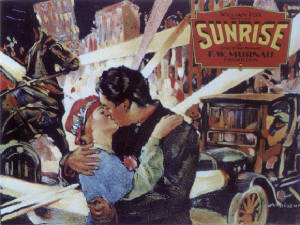|

(1927, directed by F.W. Murnau)
- inducted 2013 -
"I always think of F. W. Murnau’s Sunrise: A Song of Two Humans with a fair degree of melancholy.
It’s one of the glories of the cinema, sure. But it’s also a kind elegy for silent films as they were about to
be swept into the dustbin of history. Silent film had developed to a high degree of visual sophistication by the time Sunrise
appeared and that sophistication is imprinted on every single frame of the film. Unfortunately, Sunrise appeared a
month after The Jazz Singer. It was obsolete on arrival, arguably the last fireworks display of the era. The camera
that Murnau had liberated from its moorings on the floor of the studio was remounted there as film had to learn everything
over again to accommodate sound.
"At first glance, Sunrise is a simple, almost a simplistic movie. Femme fatale from the city convinces farmer to murder
his wife and run off with her. Farmer can’t go through with it, but wife runs off. He pursues her. A long night of the
soul follows. This is an artifact that clings to America’s self-image--already profoundly obsolete in 1927--as an agrarian
nation. The country is wholesome in this film’s worldview. The city, a carnival of temptation. Frankly, it’s kind
of corny. It’s an awful story. But then, it’s not really interested in story. It’s interested in images.
The image is king here, and this is a tour de force in putting images on screen. The cascade of images, sometimes multiple
images on the same screen, is intoxicating. The subtitle, 'A Song of Two Humans,' betrays the film’s intent not as narrative,
but as poetry. The movie frame is a line, scenes are stanzas. As such, each frame is loaded with meaning. For all that,
it’s such a living, breathing film that it takes time out for comedy here and there, and for suspense. It never leaves
the frame without something to watch. Or someone.
"The technical bona fides in Sunrise are daunting. Everything in the movie was built to order. Both the city and the
country were stages. The camera was suspended by cables a la those cameras that record sporting events these days. It could
move anywhere. This was Murnau’s ultimate free camera, the resulting movie, the apotheosis of his “unchained cinema.”
This became the house style at Fox in the brief moment before sound made all of this impossible, and you can see echoes of
it reverberate through cinema in films as diverse as The Wizard of Oz (which strikes me as being very similar to Sunrise)
and Citizen Kane (which is very different).
"Sunrise is one of the films for which Janet Gaynor won the first Academy Award for Best Actress. The first Oscar was
given for a body of work rather than a single performance, but Gaynor’s performance here is of a piece with the two
other films for which she won. Sunrise pairs with both Seventh Heaven and Street Angel for a formidable
double or even triple feature. All of them are suffused with a delirious romanticism of a kind that vanishes from talking
films, even once they relearned most of what they forgot from the silents. And all of them are devoted to the poetry of the
image over the ruthlessness of narrative. The movies lost more than they gained from sound, at least in terms of the poetics
of cinema. There’s not another film like Sunrise anywhere afterward. It’s one of the most beautiful things
on this green Earth."
~ Christianne Benedict
Original title: Sunrise: A Song of Two Humans
Principal cast: George O’Brien, Janet Gaynor, Margaret Livingston, Bodil Rosing, J. Farrell MacDonald, Ralph Sipperly,
Jane Winton, Arthur Housman, Eddie Boland
Screenplay by Carl Mayer (scenario), Katherine Killiker and H.H. Caldwell (titles)
From an original theme by Hermann Sudermann
Director of photography: Charles Rosher, Karl Struss
Production design by Rochus Gliese (uncredited)
Film editing by Harold D. Schuster (uncredited)
Original music by Hugo Riesenfeld (uncredited)
Makeup by Charlie Dudley (uncredited)
Special effects by Frank Williams (uncredited)
Produced by William Fox (uncredited)
USA
Duration: 94 minutes
Languages: Silent with English-language intertitles
Filmed in black and white
Sound mix: Mono (Movietone) [musical score and sound effects]
Aspect ratio: 1.33:1
Produced and released in USA by Fox Film Corporation
Premiered in New York City, NY on 23 September 1927
Awards and honors:
- National Film Registry selection, 1989
- Selected as one of Roger Ebert’s “Great Movies,” 11 April 2004
- Academy Awards (USA), 1927-1928: Best Picture, Picture, Unique and Artistic Production (won)
- Academy Awards (USA), 1927-1928: Best Actress in a Leading Role, Janet Gaynor (won)
- Academy Awards (USA), 1927-1928: Best Cinematography (won)
- Academy Awards (USA), 1927-1928: Best Art Direction (nominated)
|

